Stormwater Projects
Stormwater System CCTV Inspection & Cleaning 2022
This assessment project involved the inspection and condition assessment of the City's existing stormwater system, including pipes, culverts, and manholes. 62,000 linear feet (LF) of pipes ranging from 18 to 60-inches in diameter and 180 manholes were inspected using CCTV services provided by AQUALIS. Results of these inspections will assist City staff in identifying parts of the stormwater network that are in need of cleaning, repair, or replacement.
Stormwater Asset Inventory and Assessment 2022
The City partnered with a consultant in 2020 to begin a comprehensive inventory and assessment of the City's stormwater network. The inventory benefits the city by helping city staff and citizens locate stormwater conveyances and structures. The stormwater infrastructure inventory is also a requirement of the City's Phase II National Pollution Discharge Elimination System (NPDES) permit. As of May 2022 over 2,500 structures and 35 miles of pipe have been identified. The data is essential to the City's goal of developing a comprehensive asset management plan for the stormwater system.
Stormwater Utility and Rate Study 2021
Beginning in 2019 the City partnered with WithersRavenel to complete a Stormwater Utility and Rate Study. Withers Ravenel assisted the City in defining the current Level of Service for the stormwater program, helped facilitate an informed decision making process with City Council where Council was able to determine the level of service it desires to achieve in the future, and ascertaining an appropriate Level of Service to achieve in the future. The analysis addressed project financing and future stormwater fees. In conducting this study, WithersRavenel examined the past and present fees, reviewed previously prepared studies and growth projections, and analyzed the financial impact projected changes would have on the fund and parcel owners.
Hendersonville Stormwater Utility & Rate Study 2021
Based upon the analysis, Withers Ravenel concluded that the Stormwater Fund could recovers its system costs through the implementation of a $5 per ERU fee. However, a static stormwater fee will not be enough for future increases in operating costs, permit compliance requirements, and planned capital projects. The adopted stormwater fee allows for the phase‐in of additional operating and capital costs associated with the CIP. More information about the Stormwater Utility can be found here: City Stormwater Utility
Wash Creek Watershed Master Plan 2019
In 2018 The City of Hendersonville engaged WithersRavenel to develop a stormwater master plan
for the Wash Creek subwatershed. The Wash Creek Watershed is approximately 1378 acres. The goal of the
stormwater master plan was to identify and prioritize capital improvement projects in the Wash Creek subwatershed that allowed the City to begin planning and budgeting for improvements to the stormwater system.
Stormwater Stroll
Stormwater Measures Highlighted in Patton Park
The City of Hendersonville Stormwater Management Program invites the public to take a walk along the ‘Patton Park Stormwater Stroll.’ This series of Stormwater projects implemented by the City are now accompanied by educational signage aimed at engaging and teaching park visitors about water quality.
“All the features you see along the Patton Park Stormwater Stroll are designed to mimic how nature would treat stormwater if there were no pavement or buildings around,” said Stormwater Administrator Michael Huffman. “People may not be familiar with some of these treatment methods, so the signs are a great way for people to learn while they enjoy the walking path and amenities at Patton Park.”
The green infrastructure installed in Patton Park and highlighted along the stroll include:
• Rainwater Cisterns: Two large cisterns accompany the City’s Public Works Grounds and Maintenance Facility to catch rainwater off the roof of the building. The captured rainwater is used to wash vehicles and equipment. The cisterns include water quality murals painted by Girl Scout Isabella Conway.
• Bioretention Pond: A basin filled with vegetation and engineered soil that holds runoff and filters out pollutants is located adjacent to the maintenance facility.
• Rain Gardens: A series of rain gardens capture runoff from the parking area and basketball courts. The rain gardens will eventually be planted with native wildflowers and plants to act as a pollinator habitat while removing pollutants before the water enters the groundwater.
• Permeable Paving: A permeable paving system near the park’s entrance reduces water pollution by filtering sediment and chemicals.
• Stormwater Wetland: The re-engineered duck pond treats stormwater by filtering and absorbing pollutants before water enters the water system. The wetland controls the rate of runoff to protect Brittain Creek from erosion and improves the bird, pollinator, and wildlife habitat.
Collectively these features are expected to treat over 1 million gallons of polluted runoff each year. The City of Hendersonville was awarded a NC-319 Grant from the NC Department of Environmental Quality to help fund a portion of the new stormwater control measures in Patton Park.
The stormwater wetland construction is part of the City’s Multi-area Streambank Restoration Project. This project has restored streambanks and protected existing infrastructure at thirteen sites throughout Hendersonville. Patton Park is the most visible site, and the public will notice stream buffer enhancements, live-stake plantings, and invasive species removal along Brittain Creek in addition to the sanitary sewer replacement that was installed over the fall and winter season. The project is nearing completion with additional plantings scheduled, but the walking path has reopened, and the public can enjoy the eco-friendly recreational and play areas.
New Street Sweeper!
Clean Streets = Cleaner Streams
There is a new water quality hero in town, and they are helping protect our waterways with each and every mile they travel. For City of Four Seasons residents, the City of Hendersonville street sweeper is cleaning up debris on a street near you.
"Street sweeping is a city service that provides a number of benefits including significantly reducing the amount of toxic inputs found in urban stormwater runoff," said Stormwater Administrator Michael Huffman. "Things like oil, grease, brake dust, trash, dirt and leaves all become pollutants when picked up by stormwater runoff and carried to the nearest stream or creek."
The new street sweeper started traveling Hendersonville's thoroughfares in the summer of 2019 and runs every Monday – Friday. The Public Works and Stormwater Departments recently collaborated to install a graphic wrap on the apparatus to raise awareness about the City's Stormwater Program and Stormwater hotline.
Residents can report stormwater issues by calling (828) 697-3013 and find out information about the City's Stormwater Program at: www.hendersonvillenc.gov/stormwater-management
The City is currently in the process of evaluating and updating its stormwater utility structure. The stormwater utility is the revenue stream responsible for funding equipment like the street sweeper as well as managing and maintaining the public stormwater drainage system in addition to other state and federally mandated priorities. As the City grows and the infrastructure continues to age, a greater demand is being placed on the stormwater program. A rate study is underway to evaluate program needs, engage with customers, and set the utility up to be able to fund future capital improvements and investments in the stormwater system.
"The new street sweeper will help the City of Hendersonville reduce the pollutant loads from city streets," said Michael Huffman. "This piece of equipment is keeping our streams clean one mile at a time!"
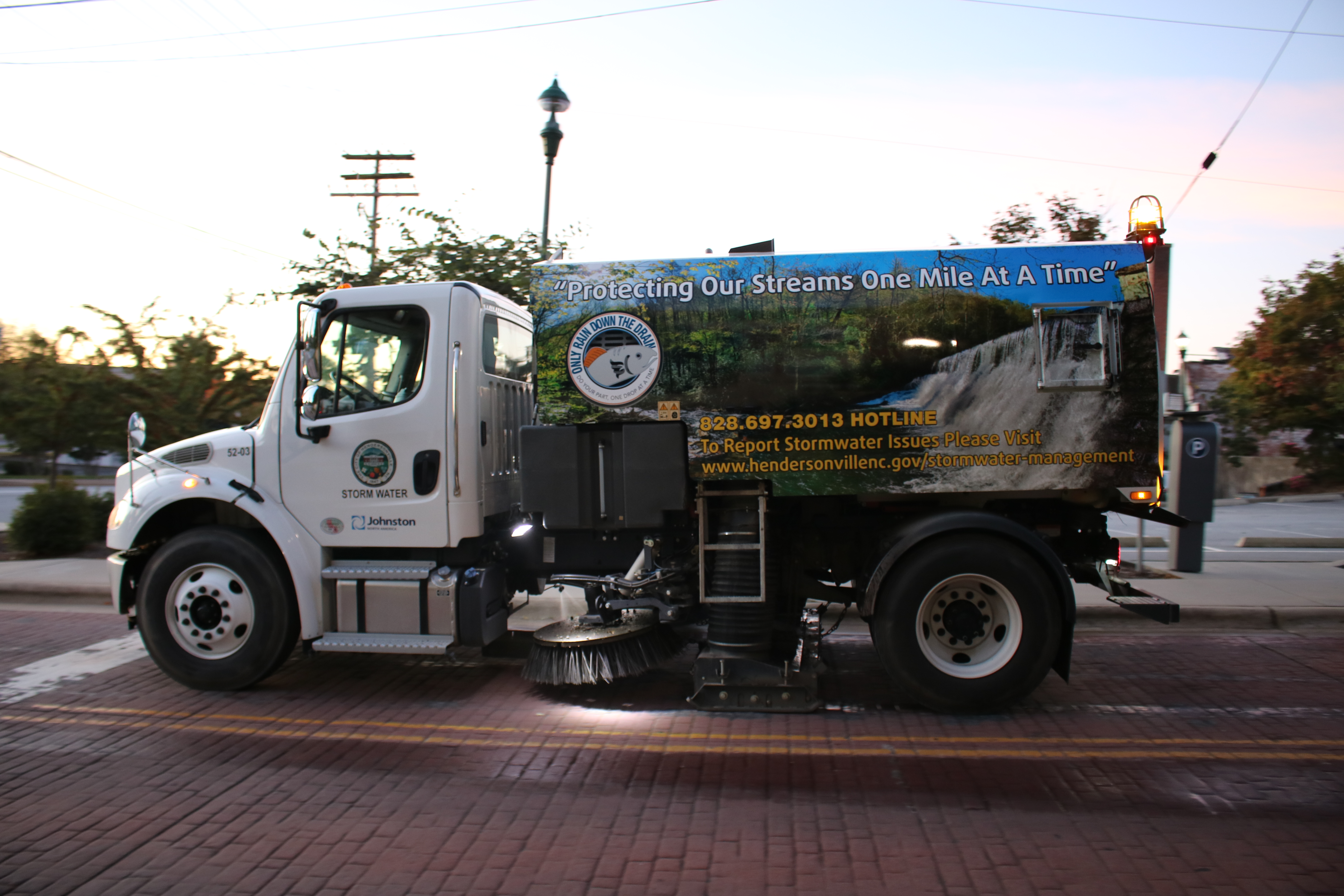
Building and Grounds Maintenance Facility Green Infrastructure
If you have taken a stroll in Patton Park or driven along North Main Street, you have probably noticed the new Public Works building that will house the City of Hendersonville Building and Grounds Maintenance crews. The facility's purpose is to store equipment and provide a workshop and office space for parks and maintenance employees, but it was also designed with the environment in mind.
"The City took the initiative to install green infrastructure at the new Public Works Facility as a demonstration project to show how stormwater can be managed in an environmentally conscious way," said City of Hendersonville Stormwater Administrator Michael Huffman. "The design provides benefits beyond stormwater treatment and includes energy savings and aesthetic improvements."
Huffman explained the goal of 'green infrastructure' is to mimic the site's pre-developed hydrology by treating stormwater at the source. Practices such as rain water harvesting, bioretention, impervious surface reduction, and permeable paving aim to slow, sink, and spread the stormwater runoff giving sediment and pollutants time to settle out of the runoff.
"The steps we've taken with the design help infiltrate the water, so it goes back into the ground instead of straight out to a stream," said Huffman.
Bioretention
Huffman explained that bioretention cells are like engineered rain gardens. They have a special soil mix that promotes microbial growth and infiltration of water which both work to treat stormwater and its associated pollutants like hydrocarbons (fuel), nutrients, and sediment. They are also perfect environments for native wildflowers, creating additional pollinator habitats within the City.
The division of Public Works in charge of maintaining the City's parks, grounds, and greenways has been hard at work landscaping the new facility in a fashion that enhances stormwater management efforts and promotes a healthy ecosystem.
"We've been planting Purple Tears Switchgrass, Bee Balm, Black-eyed Susan's, and Horsetail Grass in and around the bioretention pond," said Kevin Rhodes who supervises the Parks division. "NC State helped us with the design of the plants." He explained native wildflowers were chosen because they help absorb stormwater and will attract bees, butterflies, and birds.
Rain Harvesting System
A rain water harvesting system is part of the facility's design. Roof runoff is directed to large cisterns that store water which can either be used on-site for activities like washing vehicles or irrigation or can be allowed to slowly drain so that the water has a chance to infiltrate into the ground.
"We are using rain water cisterns to capture runoff from the facility," said Michael Huffman. "The roof runoff will be stored in two 5,000 gallon cisterns and be used for washing equipment at the facility."
The rain water harvesting portion of the system is being funded by a grant awarded to the City through the NC-319 Program
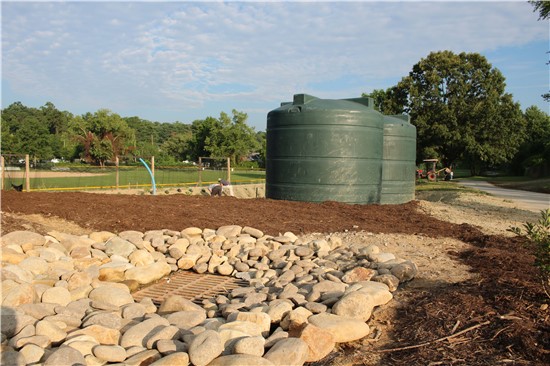
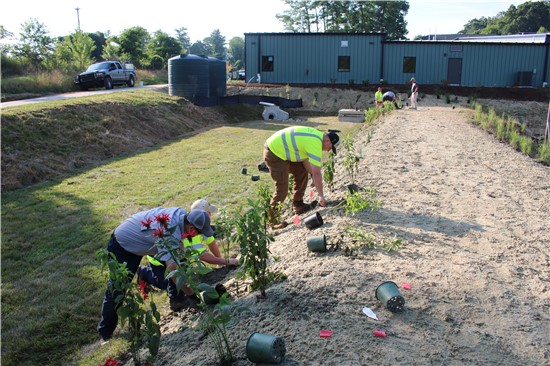
Aquatic Litter Reduction: Trash Trout
GreenWorks Trash Trout
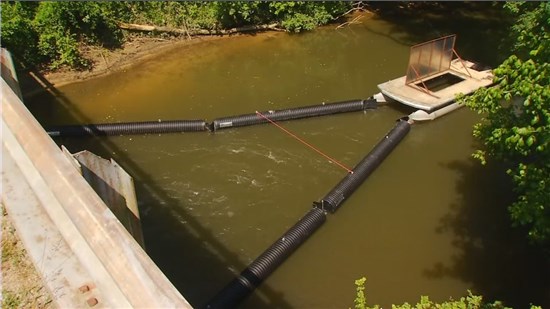
Aquatic trash has become a pervasive problem in freshwater environments, presenting a challenge to water quality and habitat protection, in addition to causing aesthetic blight, ecological effects, economic impacts, and possible public health risks.
Mud Creek has been listed as impaired on North Carolinas 303(d) list since 2006 and is the largest conveyor of water borne trash to the French Broad River in Henderson County. After a heavy rain, the creek can explode in volume as it sheds over 200 square miles of urban and rural areas. To address the trash in higher flowing creeks, Asheville GreenWorks developed a device capable of withstanding greater volumes of water, while not impairing the local ecology.
City stormwater staff, in partnership with non-profit organizations Asheville GreenWorks and Mountain True have installed a trash collection device on Mud Creek in an effort to reduce floating trash in Mud Creek. This project will offer opportunities for public education and outreach as well as generate public involvement in water quality and stormwater management.
The device, named the "Trash Trout" was designed and built by the Asheville GreenWorks organization. Its purpose is to sit in a flowing waterway and collect floatables as they move downstream with the current. This device aids in reducing the amount of trash in our waterways and improving overall water quality for our community. Asheville GreenWorks, The City of Hendersonville Stormwater Department, Mountain True and various community groups are partnering to maintain the device located at Balfour Bridge on Mud Creek.
Help us keep the Trash Trout in the water. Asheville GreenWorks is seeking volunteers to maintain this device. Contact Eric Bradford / 828-232-7144 or Michael Huffman / 828-458-5693, mhuffman@hvlnc.gov if you're interested in helping out with the Trash Trout device.
Related Articles:
'Trash Trout' device stops trash from getting into the French Broad
'Trash Trout' installed on Mud Creek
Greenworks' new 'Trash Trout' device works to clean Hendersonville waterway
Rain Barrel Program

The purpose of the Rain Barrel Program is to generate public involvement in the stormwater program by providing rain barrels at a discounted price to the citizens of Hendersonville. Rain Barrels offer a number of benefits to the community and residents including reducing stormwater runoff pollution from residential lots, allowing residents to store and use rainwater for irrigation and gardening during times of drought, lowering water bills, and reducing the demand on municipal water treatment and supply. Rain Water Solutions, a North Carolina based company, offers a community partnership program that provides high-quality rain barrels to participating municipalities and a discounted price to residents.
Since the program began over 800 Barrels have been distributed, equivalent to 40,000 gallons of rainwater being conserved each time it rains. This program is coordinated by the Stormwater Division for the City of Hendersonville. If you have any questions or would like more information regarding the Rain Barrel program please call: 828-697-3013 or email: mhuffman@hvlnc.gov
Rain Water Harvesting at Ironwood Square
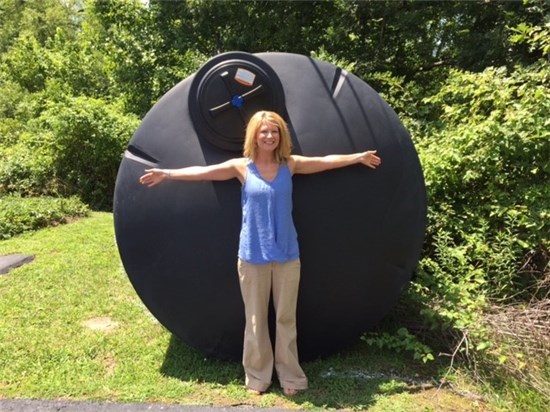
It all started with a bike ride. Torry and Michael ride their bikes together on a weekly basis and as is often the case they talk about their families, what they did on the weekend, and their jobs. Torry Nergart is the Conservation Easement Manager for Carolina Mountain Land Conservancy (CMLC) and Michael Huffman works for the City of Hendersonville as Stormwater Quality Specialist. Michael told Torry he thought Ironwood Square, where The Free Clinics (TFC) is located, would be a great place to demonstrate water conservation, and that he could offer a grant to help finance the project. Furthermore, North Carolina State (NCS) through the College of Agricultural and Life Sciences and the NC Cooperative Extension would design and install the entire system, including a cistern, drain pipes, and an electric pump. After walking the property in April they determined that of the three tenants at Ironwood Square, TFC, CMLC, and Children & Family Resource Center, TFC's site and our Community Garden made for a perfect fit.
Thus was born the Ironwood Square Rain Water Harvesting System. NC States's Mitch Woodward is the project manager, and TFC's Cassie Ashworth (shown above) has coordinated TFC's engagement and our responsibilities. The system is being installed.
The 5,000 gallon tank, which measures 102" in diameter and 152" high, will capture approximately 3.5 inches of rainfall, which is nearly a month of average rainfall for our area. The rainwater will be funneled from gutters located along two sides of the TFC building into the cistern. An electric pump will be installed in the middle of our garden to send the water from the cistern to irrigate the beds. The project costs are estimated at $6,872, which is covered by a grant from the City of Hendersonville.
"We feel fortunate that the City of Hendersonville and NC State selected TFC for this project," said Cassie. "This collaboration is a great way to demonstrate water conservation and the value of community partnerships, and will enable us to expand the garden next year which will have a positive impact on our patients."
Once installed and operational the water harvesting system will enable TFC's Community Garden to continue to expand. Last year we started with three raised beds, which this year grew to ten raised beds and an in-ground plot. Thankfully, patient volunteers assumed greater responsibility for planting, weeding and harvesting. With an adequate water source, our garden can continue to grow, providing increased access to fresh produce for our patients.You never know where great ideas may be born. As Cassie remarked, "This awesome collaborative project all came about thanks to a bike ride!"
Bruce Drysdale Rain Garden Workshop
Bruce Drysdale Rain Garden
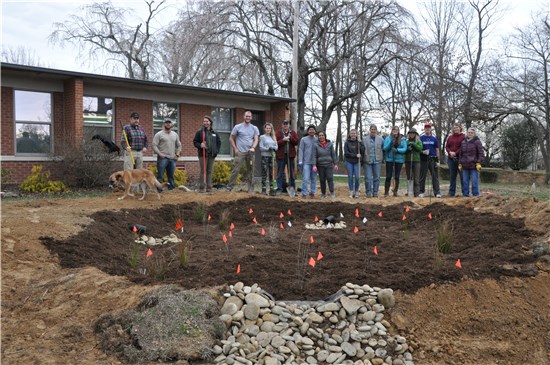
The City of Hendersonville Stormwater Division is excited to announce the installation of new stormwater rain garden at Bruce Drysdale Elementary in Hendersonville. This rain garden highlights the amazing work that can be accomplished when various community organizations collaborate and work together on a project. The installation of this rain garden will aid in managing stormwater runoff from Bruce Drysdale Elementary, this innovative but simple method of stormwater management reduces pollution and flooding downstream by holding rain water onsite and allowing it to slowly infiltrate back into the ground.
Besides the benefit to the local water quality, rain gardens are excellent education projects because they serve as living classrooms, creating education opportunities focused on the water cycle, soil, plants, pollinators, and stormwater. Throughout the school year teachers and students can use the rain gardens for lessons and activities, and they will work with community volunteers to care for the rain garden. Additionally, this rain garden will serve as a demonstration project for others who are interested in a more environmentally friendly way to manage stormwater runoff on their property.
This project was the focus of a workshop hosted in partnership with the Girls Scouts of America, NC State and the NC Cooperative Extension Office, Hendersonville Tree Board, Hendersonville Water and Sewer Department, and Henderson County Public School. Attendees of the workshop were educated on how to locate, design, and install a rain garden. Over 20 people participated in the event and helped to install the rain garden at Bruce Drysdale. The City of Hendersonville Stormwater Division would like to thank everyone involved who made this project a huge success!
The Stormwater Division has a goal to install at least one new rain garden a year moving forward. If you are interested in having a rain garden or would like more information about this innovative stormwater practice please contact Michael Huffman at mhuffman@hvlnc.gov or by phone at 828-697-3013
Britton Creek Stormwater Master Plan 2011
In 2008, The city identified a funding opportunity to develop a stormwater management plan for the Britton Creek watershed. An application was made to the Clean Water Management Trust Fund (CWMTF) and the Fund provided a Stormwater Mini-Grant to aid the City of Hendersonville in this effort. The City created a project summary with water quality objectives that include the creation of a Stormwater Master Plan (SWMP) for the Britton Creek Watershed (Appendix 9.2) that was approved by CWMTF. The SWMP included a Capital Improvement Plan.
In order to develop a reasonable and fact-based capital improvements plan, the updated inventory included the condition of structures, stream banks stability, channel bed characteristics, water quality issues, possible discharges of wastewater that should be connected to the sanitary sewer (illicit discharges under the NPDES Phase II Stormwater Program), and other potential conditions that could affect stormwater management and water quality impacts. This data in conjunction with results of other analyses gives a more complete picture of stormwater infrastructure condition and better documentation of existing water quality factors in the Britton Creek watershed.